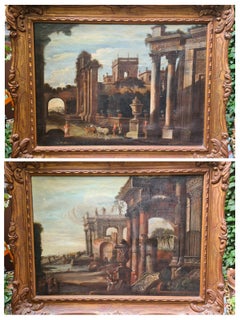Solimena Francesco
Attribution to Francesco Solimena "Resurrection of Christ" 18th Century
By Francesco Solimena
Located in Madrid, ES
Attribution to Francesco Solimena "Resurrection of Christ" 18th Century
oil on canvas (129x77 cm
Category
Antique Early 18th Century Italian Baroque Wallpaper
Materials
Paint
$14,443
H 50.79 in W 30.32 in D 2.76 in
17th Century Myth of Diana and Ataeon Francesco Solimena Oil on Canvas Blu Red
By Francesco Solimena
Located in Sanremo, IT
and 120 x 140 with frame by the painter Francesco Solimena.
According to the myth, during a hunting
Category
Late 17th Century Italian School Figurative Paintings
Materials
Canvas, Oil
$19,499
H 43.31 in W 51.19 in D 1.19 in
FRANCISCO SOLIMENA (Canale di Serino 1657 -Naples 1747) Attributed "Saint Agnes"
By Francesco Solimena
Located in Madrid, ES
is attributed to the painter Francesco Solimena, whose works are characterized by delicate modeling
Category
Antique 17th Century Italian Baroque Paintings
Materials
Paint
$6,620
H 29.93 in W 22.05 in D 1.97 in
Allegory Of Europe Solimena 18th Century Paint Oil on canvas Old master Italy
Located in Riva del Garda, IT
Francesco Solimena (Canale di Serino 1657 - Barra 1747)
workshop/circle
The Allegory of Europe
Category
18th Century Old Masters Paintings
Materials
Oil
$8,637 Sale Price
20% Off
H 46.86 in W 36.23 in
Erminia and the Shepherds, a painting by Francesco de Mura (Napoli 1696 - 1782)
By Francesco de Mura
Located in PARIS, FR
of the painter Domenico Viola, De Mura joined, at the age of 12, the studio of Francesco Solimena
Category
1760s Old Masters Figurative Paintings
Materials
Canvas, Oil
Italian 18th Century Oval Religious Oil on Canvas Painting with Saint Dominic
By Francesco de Mura
Located in Firenze, IT
painting could be attributed to the famous artist Francesco Solimena.
The canvas, although of convenient
Category
18th Century Old Masters Figurative Paintings
Materials
Canvas, Oil
$13,240
H 21.66 in Dm 15.75 in
Alexander The Great De Mura 18th Century Paint Oil on canvas Old master Italy
Located in Riva del Garda, IT
attributed to a painter working in his workshop.
A favourite pupil of Francesco Solimena, De Mura was one
Category
18th Century Old Masters Paintings
Materials
Oil
$8,136 Sale Price
20% Off
H 33.47 in W 44.49 in
Antique Oil Painting "Sacrifice to Minerva" Odoardo Vicinelli Letterfourie 18thC
Located in London, GB
Minerva, in classical flowing white robes, surrounded by a crowd of people.
Francesco Solimena (4
Category
Antique 1750s Italian Paintings
Materials
Canvas
$10,866
H 34.26 in W 66.15 in D 1.97 in
18th Century by Evangelista Schiano Saint Gennaro Oil on Canvas
Located in Milano, Lombardia
Francesco Solimena for Salerno Cathedral. The work is attributed to one of Solimena's pupils: Evangelista
Category
Mid-18th Century Old Masters Portrait Paintings
Materials
Canvas, Cotton Canvas, Oil
$13,480
H 40.16 in W 29.14 in D 1.97 in
17th Century Figures Harvesting in a Hilly Landscape
Located in Stockholm, SE
from Nicola Maria Rossi to Francesco Solimena, to the name Grano. Her studies has enabled a better
Category
Late 17th Century Italian School Figurative Drawings and Watercolors
Materials
Paper, Ink, Watercolor
$1,986
H 7.56 in W 5.01 in D 0.2 in
Still-Life Flowers Ascione 17/18th Century Paint Oil on canvas Old master Italy
Located in Riva del Garda, IT
the Neapolitan climate split between Giordano and Francesco Solimena (also in its connections with the
Category
17th Century Old Masters Paintings
Materials
Oil
$18,651 Sale Price
20% Off
H 40.95 in W 51.97 in
Pair of Grand Tour 18th Century Veduta Capriccio Paintings, After Gennaro Greco
Located in Cotignac, FR
landscapes.
Pietro Capelli trained under Francesco Solimena and worked in his native Naples in the early
Category
18th Century Baroque Landscape Paintings
Materials
Oil, Canvas
$17,316 Sale Price
20% Off
H 35.44 in W 45.67 in D 3.55 in
Grand Tour 18th Century Veduta Capriccio Painting, After Gennaro Greco
Located in Cotignac, FR
views of completely imaginary landscapes.
Pietro Capelli trained under Francesco Solimena and worked in
Category
18th Century Baroque Landscape Paintings
Materials
Oil, Canvas
$9,147 Sale Price
20% Off
H 35.44 in W 45.67 in D 3.55 in
Large Grand Tour 18th Century Capriccio Painting Roman Ruins after Gennaro Greco
Located in Cotignac, FR
under Francesco Solimena and worked in his native Naples in the early 18th century. Mainly a painter of
Category
18th Century Baroque Landscape Paintings
Materials
Oil, Canvas
$9,147 Sale Price
20% Off
H 35.44 in W 45.67 in D 3.55 in
Female Figure - Original Etching on Paper by Domenico Cunego - 1777
Located in Roma, IT
Antonio Balestra, Francesco Solimena, and Felice Boscaratti, but also for the work with British artists
Category
1770s Figurative Prints
Materials
Etching
$270 Sale Price
25% Off
H 8.86 in W 5.52 in D 1.19 in
Portrait of Languid Girl in Blue Camisole 18th century Italian Rococo Master
Located in Stockholm, SE
and 1734, he worked with Francesco Solimena in Naples. He then returned then to Verona, where he
Category
Mid-18th Century Realist Portrait Paintings
Materials
Canvas, Wood, Oil
$22,200
H 33.3 in W 27.4 in
Recent Sales
San Filippo Neri’s Rapture Painting by Francesco Solimena, Naples, 18th Century
By Francesco Solimena
Located in Firenze, IT
Francesco Solimena, oil on canvas.
Beautiful painting portraying San Filippo Neri’s rapture
Category
Antique 18th Century and Earlier Italian Paintings
Materials
Canvas
H 33.47 in W 22.45 in D 1.97 in
Saint Peter & The Angels - 17th Century Oil, Religious Figures by F Solimena
By Francesco Solimena
Located in Marlow, Buckinghamshire
Oil on canvas circa 1690 by Francesco Solimena. Framed dimensions are 30.5 inches high by 24 inches
Category
Late 17th Century Old Masters Figurative Paintings
Materials
Canvas, Oil
Important Painting French School of the 19th Century "Academic Nude"
By Francesco Solimena
Located in Madrid, ES
Important Painting French School of the 19th Century
"Academic Nude"
Oil on canvas
79 x 50 cm without frame
89cm x 60cm with frame
good condition
Category
Antique 19th Century French Neoclassical Wallpaper
Materials
Paint
A Pair of Fortuny Fabric Cushions in the Solimena Pattern
Located in New York, NY
Neapolitan Baroque painter, Francesco Solimena (1657-1747).
50 down/50 feather insert.
Newly made using
Category
2010s American Baroque Decorative Objects
Materials
Cotton, Linen, Silk
The Death of Saint Joseph, Italian Baroque Religious Scene Oil on Canvas Painting
By Francesco de Mura
Located in Firenze, IT
centuries, Francesco Solimena. His most talented pupil, Francesco De Mura, declines this subject -already
Category
Early 18th Century Old Masters Figurative Paintings
Materials
Canvas, Oil
H 35.44 in W 24.41 in D 1.19 in
The Allegory of Europe Oil on Canvas Italy XVIII Century
Located in Milan, IT
Oil on canvas. It is a counterpart copy of the original attributed to Francesco Solimena (1657
Category
18th Century Other Art Style Figurative Paintings
Materials
Oil
18th Century Nicola Maria Rossi Portrait Noble Man Oil on Canvas Black White
Located in Sanremo, IT
workshop of Francesco Solimena in 1706. Initially he adhered so faithfully to the master's style that his
Category
Mid-18th Century Italian School Portrait Paintings
Materials
Canvas, Oil
H 23.63 in W 19.69 in D 1.19 in
18th Century Antique Oil on Canvas Painting Portrait of a Italian Prelate
Located in Casale Monferrato, IT
eighteenth century. The image suggests clear influences drawn from Francesco Solimena's portraiture. The
Category
Antique 1750s Italian Paintings
Materials
Canvas
H 40.56 in W 33.08 in D 1.97 in
(French School) 18th Century, An Exceptional Quality Portrait of Venus and Cupid
Located in Queens, NY
Traversi, was a student at the large studio of Francesco Solimena. One of his contemporaries there was
Category
Antique 18th Century French Paintings
Materials
Paint
H 40 in W 35 in D 3 in
Giuseppe Bonito (Italian, 1707-1789) A Large Portrait of a Gentleman
Located in Queens, NY
studio of Francesco Solimena. One of his contemporaries there was Gaspare Traversi. Bonito represented
Category
18th Century Rococo Portrait Paintings
Materials
Oil
17th Century Games Between Putti Neapolitan School Painting Oil on Canvas
Located in Milan, IT
Francesco Solimena (known as the Abbot Ciccio, 1657-1747); the Neapolitan lymph can even be seen in the
Category
Antique 17th Century Italian Paintings
Materials
Canvas
H 26.78 in W 51.19 in D 3.94 in
(Triumph of) Galatea
Located in Saint Augustine, FL
fellow-countrymen like Guido Reni and Italian contemporaries such as Antonio Balestra, Francesco Solimena
Category
1770s Old Masters Figurative Prints
Materials
Engraving, Etching
The Madonna & Child, early 1700's Italian Old Master oil painting
Located in Cirencester, Gloucestershire
Naples, and apprenticed in Naples under Francesco Solimena. In 1706, along with his brother Giovanni, who
Category
Early 18th Century Old Masters Figurative Paintings
Materials
Canvas, Oil
17th Century Italian Old Master Painting - Time unveiling truth - Allegory Dark
By Francesco Solimena
Located in Aartselaar, BE
modelling of the figures are very close to the work of Solimena. In typical Italian Old Master fashion, the
Category
Late 17th Century Old Masters Figurative Paintings
Materials
Oil, Canvas
H 18.12 in W 22.45 in D 0.79 in
17th-18th Century Italian Neapolitan Drawing
Located in CH
An 18th century Italian Neapolitan drawing by a Follower of Francesco Solimena (October 4, 1657
Category
Antique 18th Century and Earlier Italian Baroque Drawings
Materials
Paper
Saint Joseph Paint Oil on canvas De Mura Italy Baroque Art Quality 18th Century
Located in Riva del Garda, IT
successful apprenticeship in the workshop of Francesco Solimena, remaining for a long time his favorite and
Category
18th Century Old Masters Paintings
Materials
Oil
Portrait of Joseph Benwell Original Oil Painting 18th Century
By Sir Allan Ramsay
Located in London, GB
studio of Francesco Solimena.
Invigorated by his experience under the Italian-baroque masters on the
Category
1750s Old Masters Portrait Paintings
Materials
Canvas, Oil
Latinus welcomes Aeneas and offers his daughter Lavinia in marriage
By Francesco de Mura
Located in New York, NY
De Mura was initially trained by Domenico Viola, but entered the workshop of Francesco Solimena in
Category
18th Century and Earlier Old Masters Paintings
Materials
Oil, Canvas
The Mystic Marriage of St. Catherine of Alexandria
By Corrado Giaquinto
Located in New York, NY
education was in Naples, in the studio of Nicola Maria Rossi, a student of Francesco Solimena, and possibly
Category
18th Century Rococo Paintings
Capriccio
Located in Petworth, GB
century, little is known of the artist other than his huge talent and that he studied under Francesco
Category
Antique 18th Century Italian Paintings
Materials
Canvas
Late 17th Century Italian School Oil on Canvas Religious Study Fragment
Located in Bedford, Bedfordshire
include the Genoese Giovanni Battista Gaulli and the Neapolitans Luca Giordano and Francesco Solimena
Category
Antique Late 17th Century Italian Baroque Paintings
Materials
Canvas
People Also Browsed
Banquet Attrib to Van Den Hoecke Religious Oil on Table Old Master 17th Century
By Gaspar van den Hoecke (Antwerp, 1585 - 1648)
Located in Riva del Garda, IT
Gaspar van den Hoecke (Antwerp, 1585 - 1648)
Herod's banquet
Early 17th century
oil on panel, with gold highlights (in the guise of Salome and in the curtains of the building in the...
Category
17th Century Old Masters Paintings
Materials
Oil
$15,633 Sale Price
20% Off
H 28.35 in W 35.44 in
Mid-Victorian Moorish wrought & cast iron pergola or decorative garden structure
Located in London, GB
A monumental Moorish mid-Victorian wrought iron Pergola or Decorative Garden Structure, a unique masterpiece in High Victorian Ironwork design. Our research confirms it is French, da...
Category
Antique Late 19th Century European Moorish Architectural Elements
Materials
Wrought Iron
$119,177
H 240 in W 552 in D 120 in
17th Century French Old Master Oil Painting Classical Robed Semi Nude Figures
Located in Cirencester, Gloucestershire
17th century French School
circle of Nicolas Poussin (French 1594-1665)
"Figures in Arcadia"
oil on canvas, unframed
canvas: 16 x 20 inches
provenance: private collection, England
co...
Category
17th Century Old Masters Figurative Paintings
Materials
Oil, Canvas
$5,395 Sale Price
30% Off
H 16 in W 20 in
Rare 19th Century Italian Memento Mori Bust / Sculpture Carrara Marble Vanitas
Located in Ijzendijke, NL
Masterfully carved Italian Vanitas / Memento Mori bust in solid marble from late 19th century.
White Carrara marble skull combined with masterfully carved hood & robes all from one...
Category
Antique Late 19th Century Italian Renaissance Revival Busts
Materials
Carrara Marble
$22,863
H 28.75 in W 15.75 in D 8.67 in
Le Concert des Sirènes
By Adolphe Lalyre
Located in Paris, FR
Adolphe La Lyre
1850-1935 French
Le Concert des Sirenes
Oil on canvas
Signed lower right
Canvas: 32" high x 24" wide
Frame: 39 1/2" high x 31" wide
Seal Exhibition at Salon d...
Category
Late 19th Century French School Nude Paintings
Materials
Canvas, Oil
L'hymne du Roi David (King David's Dream)
By Marc Chagall
Located in Boca Raton, FL
L'hymne du Roi David (King David's Dream)
Oil on wood by Marc Chagall c late 70's
Comes with Numbered and Verified Certificate of Authenticity from Comite Chagall in Paris signed and...
Category
1970s Abstract Expressionist Figurative Paintings
Materials
Oil, Wood
$372,000 Sale Price
56% Off
H 9 in W 16.2 in D 2 in
Portrait of Madonna at Prayer - Italian Old Master art religious oil painting
By Giovanni Battista Salvi da Sassoferrato
Located in London, GB
This rather special Italian Old Master religious portrait oil painting is attributed to a follower of Giovanni Battista Salvi, or Sassoferrato as he is better known. Painted circa 17...
Category
1790s Old Masters Portrait Paintings
Materials
Oil
$8,524 Sale Price
20% Off
H 32 in W 26 in D 2 in
Tiffany Studios Rare Empire Jewel Table Lamp
By Tiffany Studios
Located in Dallas, TX
Tiffany Studios Empire Jewel Table Lamp
Important and rare Tiffany Studios New York "Empire Jewel" Table Lamp, Only 2-3 known to exist and well documented in Alastair Duncans Tiffan...
Category
Vintage 1910s American Art Nouveau Table Lamps
Materials
Bronze
Esther in the Women's House of Ahasuerus
By Artus Wolfort
Located in New York, NY
Born in Antwerp, Artus Wolffordt received his training in Dordrecht where he became a master in 1603 at the age of twenty-two. He returned to his native city in 1615 and initially w...
Category
17th Century Old Masters Paintings
Materials
Oil, Panel
Raimundo de Madrazo y Garreta Palatial Oil on Canvas Portrait Isabelle McCreery
By Raimundo de Madrazo y Garreta
Located in LA, CA
Raimundo De Madrazo y Garreta (Spanish School, 1841-1920) an exceptional and palatial oil on canvas "Portrait of Isabelle McCreery” depicting an elegant woman gracefully exiting a li...
Category
19th Century Romantic Figurative Paintings
Materials
Oil
$475,000
H 132 in W 87.5 in D 8 in
F. Barbedienne, A Suite of Three French Ormolu and Champleve Enamel Jardinieres
By Ferdinand Barbedienne
Located in Queens, NY
Ferdinand Barbedienne, An Exquisite Suite of Three French Ormolu and Champleve Enamel Jardinieres / Garniture C. 1870, The Design Attributed to Louis Constant Sevin.
Comprising of t...
Category
Antique 19th Century French Napoleon III Planters, Cachepots and Jardini...
Materials
Bronze, Enamel, Ormolu
$60,000
H 5 in W 8 in D 5 in
Early 17th Century School of Peter Paul Rubens “The Holy Family” Oil on Canvas
Located in Doha, QA
This is an absolutely incredible early 17th century oil on canvas painting representing Holy Family-Virgin Mary, St.Joseph, St. Elisabeth, John the Baptist and Baby Jesus. Sir Peter ...
Category
Antique Early 17th Century Italian Baroque Paintings
Materials
Canvas
$200,000
H 27.17 in W 24.02 in D 4.73 in
Tiffany & Co. San Lorenzo Silver Flatware Service, 248 Pieces
By Tiffany & Co.
Located in New Orleans, LA
This extensive 248-piece sterling silver flatware service was crafted by the legendary Tiffany & Co. in the classic San Lorenzo pattern. Inspired by and named after the famous Floren...
Category
Early 20th Century American Renaissance Revival Tableware
Materials
Sterling Silver
The Resurrection of Christ
Located in New York, NY
Provenance:
with “Mr. Scheer,” Vienna, by July 1918; where acquired by:
Jindřich Waldes, Prague, 1918–1941; thence by descent to:
Private Collection, New York
Literature:
Rudolf K...
Category
15th Century and Earlier Old Masters Paintings
Materials
Tempera, Panel
Fine Important Restored Pair of Antique Howard & Sons Leather Chesterfield Sofas
By Howard Chairs Ltd., Howard & Sons Ltd, Howard and Sons
Located in West Sussex, Pulborough
We are delighted to offer for sale this stunning exceptionally rare pair of original early Victorian Howard & Son’s Berners street cigar brown leather, fully restored Chesterfield bu...
Category
Antique 19th Century English Early Victorian Sofas
Materials
Leather
$61,691 Sale Price / set
20% Off
H 27.37 in W 77.17 in D 36.03 in
Bed Tester Spanish Baroque Carved Dark Green & Gilded Leather Superking 6ft180cm
Located in BUNGAY, SUFFOLK
Rare, Spanish Demi-Tester, Baroque Bed With Carved, Green Painted & Gilded Posts 181cm, 6ft High, Floral Painted Leather Headboard, sold with custom made box spring mattress base, ac...
Category
Antique 1720s Spanish Baroque Beds and Bed Frames
Materials
Giltwood, Paint
$35,052
H 70.87 in W 73.23 in D 88.19 in
Get Updated with New Arrivals
Save "Solimena Francesco", and we’ll notify you when there are new listings in this category.
Solimena Francesco For Sale on 1stDibs
Find the exact solimena francesco you’re shopping for in the variety available on 1stDibs. Finding the perfect solimena francesco may mean sifting through those created during different time periods — you can find an early version that dates to the 18th Century and a newer variation that were made as recently as the 18th Century. If you’re looking to add a solimena francesco to create new energy in an otherwise neutral space in your home, you can find a work on 1stDibs that features elements of brown, black, gray and more. A solimena francesco from Studio of Sir Allan Ramsay and Francesco de Mura — each of whom created distinctive versions of this kind of work — is worth considering. These artworks were handmade with extraordinary care, with artists most often working in oil paint, paint and canvas.
How Much is a Solimena Francesco?
The price for a solimena francesco in our collection starts at $325 and tops out at $22,671 with the average selling for $15,592.









